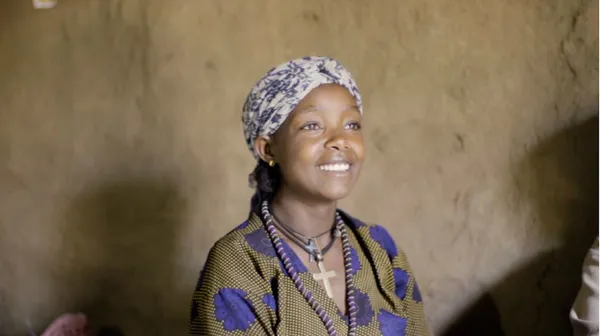 |
| Huluager Endeshaw in Sarah Noa Bozenhardt’s Among Us Women (Unter Uns Frauen), co-directed with Daniel Abate Tilahun |
My first interaction with Among Us Women (Unter Uns Frauen) director Sarah Noa Bozenhardt was when I sent in a question during the Face to Face with German Films in 2022 filmmakers panel in Berlin: “Which film you saw did you particularly like in 2021?” Her response was the documentary Displaced by Sharon Ryba-Kahn and the fiction film Precious Ivie by Sarah Blaßkiewitz.
 |
| Sarah Noa Bozenhardt with Anne-Katrin Titze (wearing Liya Kebede’s lemlem) on the fabrics: “I’m really happy that you mention this because this is something we experimented a lot with.” |
Among Us Women, co-directed with Daniel Abate Tilahun, shot by Bernarda Cornejo Pinto, and edited by Andrea Muñoz is based on the stories of Huluager Endeshaw, Endal Gedif, Welela Assaye, and Sirkalem Teshome, in a creative collaboration with the community of Megendi in Ethiopia. The documentary is produced by Sonja Kilbertus with co-producers Hiwot Admasu Getaneh and Beza Hailu Lemma.
Huluager Endeshaw, a charismatic woman in her mid-twenties is pregnant with her fourth child. Her smile lights up the screen and the more her story unfolds, the more complicated it gets. Endal Gedif, a traditional midwife in her seventies, is the second protagonist of this extraordinary documentary and her mischief and wisdom set the tone for the discussion of subject matter that is often avoided otherwise.
The film begins with a home birth under the protective shield of locally woven fabric. We see very pregnant women working the fields in this farming community. Villagers are told not to go to the traditional healers, but often there isn’t enough fuel for the ambulance and the possibility to get to the health clinic in time is fraught with different kinds of danger.
The topic of birth is complicated and so are the maneuvers of decision making when tackling the clash of tradition and what is seen as the modern world. With unprecedented access, the cinematography also never forgets to remind us of the beauty of a storm cloud or the blue flower on a local cloth in the frame.
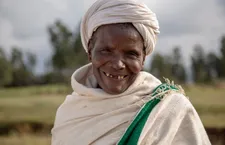 |
| Sarah Noa Bozenhardt on Endal Gedif: “Endal was the one that started everything when Daniel and I went to Megendi to visit his family.” |
Among Us Women speaks of the essential questions of life in a world that is more in flux than ever.
From Berlin, Sarah Noa Bozenhardt joined me on Zoom for an in-depth conversation on Among Us Women.
Anne-Katrin Titze: Hi!
Sarah Noa Bozenhardt: Hi, very nice to meet you!
AKT: First of all, Sarah, great film and very unpredictable! I was impressed by the fluidity of it and how you move from one subject to the other. It feels organic. Tell me a bit about that!
SNB: Yes, I think that was very much present in the shooting as well as the editing phase, that we wanted the participants and the topics we are dealing with to also guide our storytelling. It was for us filmmakers to find out in which way does the material actually speak.
We had hours of filmed material that we could work with and we could have done a topic-driven film with different perspectives opposing each other and putting that at the core of a dramaturgical arc. But it was our goal to avoid this initial instinct and to really go deep into the material and understand what are the issues at hand.
AKT: The different subjects come up in an organic way and I can almost feel what you are not doing, or where you avoid what you just described. The subject of childbirth you show in all its complexity and make clear how complicated it is for these women. It is not a plea, as a sign in the clinic says: “Thank you for not giving birth at home.” It’s much more complicated as it has to do with traditions as well as the practical concern of having enough fuel for the ambulance. Why did you choose childbirth to be the center of your film?
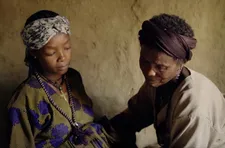 |
| Huluager Endeshaw with midwife Endal Gedif |
SNB: For me it’s very important to find connecting elements. When I think of childbirth, it’s something that all of us being on this earth …
AKT: … experienced. We were all born at some point, right.
SNB: Yes, even if it’s not consciously that we remember it, but we have gone through this process. I think that in itself it is like a human experience that can be a point of connecting with one another, even if we come from very different cultural backgrounds. Because being German, but raised in Ethiopia, I have in my identity this bridge somehow between the two countries and continents as well. I always want to create storytelling where we meet each other at eye level. So I thought that childbirth as a topic somehow lends itself, because everyone can in one way or another relate to it.
AKT: And your co-director is from that village?
SNB: Exactly. Daniel Abate Tilahun, my co-director, is also a close part of my family. We’ve been living together for many many years. He’s part of my family. My parents still live in Addis [Ababa]. Through Daniel we met everybody in the village.
AKT: You have two great protagonists. Huluager and Endal - both of them are fantastic, very expressive. How did you know these two women were the ones?
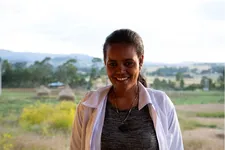 |
| Welela Assaye is a midwife at Amijaye Health Center |
SNB: Endal was the one that started everything when Daniel and I went to Megendi to visit his family. We were talking to his mom about midwifery and we had just started research. And she said let me introduce you to our midwife, who also supported Daniel’s mother through labour. So we met Endal and showed her some of our past work. Because she knew Daniel’s family so well, she felt quite comfortable.
When she saw my short film, that Daniel was also a part of, she got very excited and asked right away if we could make a film like this about her. We had thought about doing something closer to the capitol, which would have been strategically easier, but we visited her again and again. Through that word travelled in the village. This is how Huluager than approached us. I think she observed us for quite a while and then she asked to be part of the film. From that point onwards, she kind of took the whole story into her hands.
AKT: Which is great! That both of them actively wanted to be a part of this. They had the agency. On a different note, I noticed how beautiful the garments are. I am wearing lemlem today, in honor of our conversation. You are familiar with [Liya Kebede’s] lemlem?
SNB: Yes, I know of them.
AKT: There is a lot of beauty in your film, from the fabrics to a shot of a fantastic storm cloud formation. You added to the story, which is serious and urgent in parts, the aesthetic element.
 |
| Welela Assaye speaking to the women of Megendi about childbirth health concerns |
SNB: Yes, visually me and my cinematographer Bernarda Cornejo Pinto and Daniel we were talking a lot about the imagery that is present about or of Ethiopia in an international context and it’s often driven by images of poverty. We didn’t want to romanticize the living situations, but also show the wealth that everybody lives with, the beautiful environment that everyone works on in the fields and in the countryside and the land has such an importance to the farmers as well.
And the fabrics! I’m really happy that you mention this because this is something we experimented a lot with. We were thinking of how we could bring these fabrics into a presence within the film. Because it also has this sense of shelter. All the women, we always have these fabrics while we are working in Ethiopia.
In childbirth also it is the material that you can cover yourself with in your own little cocoon. It protects you from the heat, it can be like a shelter for breastfeeding. It became like this image of a comfortable, safe space as well. We wanted to create a sense of that but it’s not in the foreground. So I’m happy you picked up on that!
AKT: You feel the protection of the material. There is also the aspect of weaving, cloth making, which often goes along with the tradition of storytelling by women. You hint at the tradition of storytelling a little bit, but are there stories that you maybe didn’t have the space to include in your film?
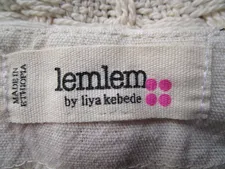 |
| lemlem by Liya Kebede Photo: Anne-Katrin Titze |
SNB: We had a lot of material, a lot of stories. I think this idea of oral storytelling is very present, more than like having myths. It’s stories of what-happened-when that are being retold over and over again. Which is something that I love. Which is also why I got inspired getting into filmmaking because I think that’s something that film can actually capture and archive in a way.
AKT: Right.
SNB: In these spaces when women are preparing for a celebration or they are weaving the baskets, like Hulu and her sister are doing, the conversations that are now part of the film are a very little selection of the broad topics and gossip as well. A lot of gossip occurs in these spaces!
AKT: The serious topic of female circumcision shows up at the hairdressers. It again feels very natural; they talk while getting their hair done. How much of an issue is this still?
SNB: It’s definitely an issue for all of the women who are part of our film. The older generation, or the grown women, it’s almost safe to say that most of them were circumcised. It wasn’t as present in their pool of issues in their everyday life. It’s again something that was very much pushed from a western perspective thematically to explore this. But if you sit down with the participants, they were more rooted in what they experience daily and not so much some traumatic event in the past.
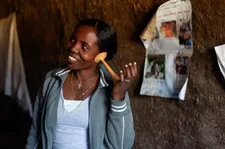 |
| Sirkalem Teshome runs the local health post |
That’s something we wanted to be honest about as well. At the hairdressers what happens and makes the scene very strong as well is that the issue is talked about through the idea of how they experience their own sexuality. It’s quite unique, the laughter that accompanies the discussion. We would be like, oh my god, this is so horrific and so very difficult. But their experience in these spaces were somehow different.
AKT: Little moments that could read as asides are really interesting. For example when Huluager is going to the clinic she is twice asked about the baby’s name and the father’s name. And not her name. I have a question about the man who is seen hitting the cows twice, is that her husband?
SNB: Yes, that’s her husband.
AKT: Where is she now? How are they doing?
SNB: They’re great, they’re good. Hulu left her husband, she got a divorce and moved back to her family. She is living on her parents’ land. Her husband supported her in this process, he helped her build a house because his children also live with her. It came through in the filmmaking process and in the scene that reveals the story about her child that she really didn’t want to stay in this marriage.
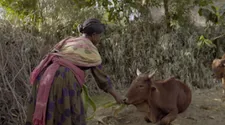 |
| Huluager Endeshaw in the fields |
Maybe through the film and the conversations that followed with her family after disclosing these secrets to us, she just decided to leave and is quite happy about that. She’s trying to figure out of course how she can support herself financially and she still receives part of the crops from her husband’s land. She is selling her baskets on our website. So there’s a way to support her if your readers are interested.
AKT: Did COVID affect them badly?
SNB: Not really. I’m not sure in which ways it may have affected the farming situation, but I met them to show the film last May, so it was during the pandemic that I travelled to Megendi to show the film to the main participants and it wasn’t very present, to be honest.
AKT: Good to hear. Thank you so much!
SNB: Thank you, take care!





















